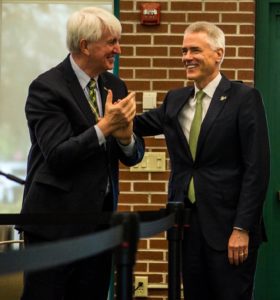Provost introduces USF president, shares plans about student success

Currall opened by thanking the faculty for welcoming him and expressed gratitude to Wilcox for helping with his transition these past two months.
“During my transition, [Wilcox] has been absolutely wonderful in welcoming me and being a great colleague and partner. I am delighted to see what he has in store this year as our chief academic officer,” Currall said.
In an effort to share details from his personal life, Currall played a video that showcased photos of him growing up and how he met his wife, Cheyenne Currall, as a Ph.D. student. He then joked that his wife is “way more interesting” than he is.
During the 2018-19 school year, Wilcox introduced his initiatives to improve the success of faculty, graduate and professional student success as well as building a digital ecosystem. On Friday afternoon, Wilcox provided updates as to how these programs have succeeded.
Wilcox spent most of his speech marveling at USF’s achievements this year including exceeding benchmark 12 for the preeminent state research metrics. USF was missing the metric for the $500 million endowment, however, there is now $515 million in the fund.
In order to maintain preeminence status, a university must meet or exceed 11 of the 12 benchmarks. USF meets all 12 of the benchmarks as of June 10.
The audience gave a resounding applause after Wilcox shared that the four-year student net cost for a baccalaureate degree in 2017-18 was $7,130. This was compared to the previous year in which the cost was $5,830 more.
“Many of our students are first in their family and come from limited economic backgrounds,” Wilcox said. “We have to keep a watchful eye in providing affordable pathways to graduation.”
As a part of his initiative to improve faculty success, Wilcox said the administration was able to maintain the same level of faculty awards, fellows and memberships as the previous year.
The audience of faculty and staff was once again pleased to hear that USF is the top school in the nation for Fullbright Scholars.
Even after sharing this year’s accomplishments, Wilcox recognized that USF still has room to improve.
In order to be recognized in the U.S. News & World Report as a top 25 university, USF would need to improve metrics such as its six-year graduation rate, average faculty salary, student-to-faculty ratio and the average spending per student.
“To be clear, we are not chasing rankings for the sake of it,” Wilcox said. “You can see there is a strong alignment between U.S News and World Report rankings and management in the Association of American Universities.”
Two of the goals Wilcox set for this upcoming year is to provide “academic quality assurance” and “eliminate barriers to progress.”
In doing so, Wilcox plans to use the Association of Public and Land-grant Universities (APLU) to retain student success.
APLU is a “research, policy, and advocacy organization dedicated to strengthening and advancing the work of public universities,” according to their website. Wilcox said using this program will help eliminate the achievement gap and “provide hundreds of thousands more degrees by 2025.”
Wilcox told the faculty to encourage students to use the program Handshake. Handshake is a program USF uses so current students and recent grads are able to find jobs in their fields. However, it doesn’t seem like many students are using this platform.
Only 35 percent of students have created a profile and 48 percent of students are logging into Handshake.
“We can and must do better with Handshake,” Wilcox said. “In order to achieve our goal of 100 percent adoption rate, we need your help as faculty members and advisors to encourage our students to activate their accounts and advance their way into the workforce.”
As of this school year, 45,000 students will be attending USF. Wilcox said it will be a priority to make sure each student’s needs are met.
“We have learned that ‘Gen Z-ers’ expect something quite different from their university experience than many of us can identify with. We must be responsive in their time and needs while working to strengthen the intellectual radar associated with USF education.”







